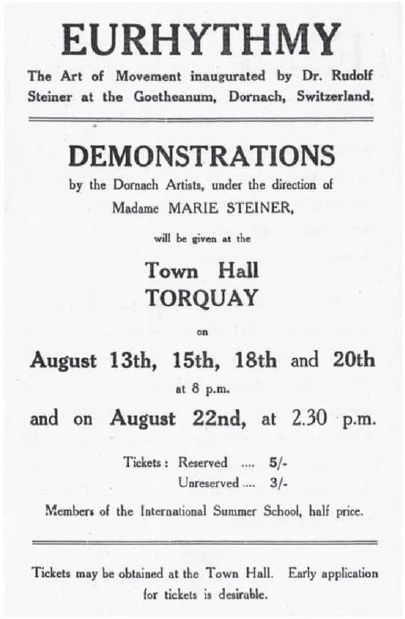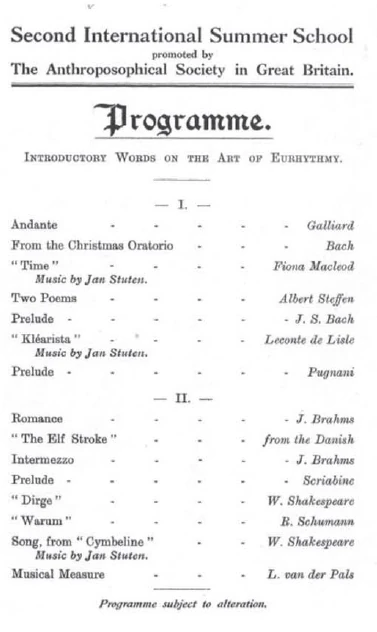The Origin and Development of Eurythmy
1923–1925
GA 277d
13 August 1924, Torquay
Translated by Steiner Online Library
Eurythmy Performance
The semi-public summer course “The True and False Paths of Spiritual Research” (GA 243) took place in Torquay from August 11 to 22, 1924, with four eurythmy performances; this was followed by a stay in London until the end of August. A eurythmy performance was also given there on August 26, 1924. Rudolf Steiner wrote an essay for the eurythmy lectures in England—his last on eurythmy—which summarizes the points he considered essential. This essay was probably translated and read aloud before the performances.
“Eurythmy”
It cannot be a question of preceding the eurythmic performance as a work of art with an introduction. Art must work through itself; and to want to explain an artistic creation is something unartistic. But in the case of eurythmic experiments, we are not dealing with the old, familiar sources of art and the familiar artistic language of form, but with something new in both respects. Therefore, allow me to say a few words about these new artistic means and this artistic language of form.
On stage, one will see moving individuals and groups of people. These movements will express the content of poems and musical creations. But this is not done through mimicry, pantomime, or dance-like gestures. Eurythmy should not be confused with these related arts, against which there is absolutely nothing to be said.
Eurythmy is a real visible language and a visible song. It is developed from the laws of human organization in the same way as sound in singing and words in speech.
This had to be achieved through careful study of what happens in the human organism during speech and singing. This cannot be achieved through ordinary physiological observation, but only through “sensory-supersensory perception.”
Such perception reveals that gestures and facial expressions are suppressed in human speech. These gestures want to emerge, but they do not; instead, they are transformed by the brain organism into formative forces that are united with the activity of the will organism and transmitted to the air through the larynx and its neighboring organs. In the study that created eurythmy, the suppressed gestures that live in speech and singing are brought to light and transferred to the whole person and to groups of people. This enables movement to be used for speaking and singing. The result is spatial movements in humans, to which ordinary facial gestures and even dance relate as babbling relates to speech.
A poem or a piece of music thus becomes visible to the eye, just as speaking or singing makes it audible to the ear.
The entire stage design can be created in the spirit of eurythmy. We also try to design the lighting effects so that their sequence becomes a visible, melodious expression of the poetic or musical work.
Parallel to the visible eurythmic reproduction of the poetic, recitation and declamation appear. When performed with eurythmy, these must also be eurythmically designed. True artistic poetry is based on speech formation. This, and not the prose content of the poetry, is the main thing. The melodious and the imaginative are contained in the shaping of words. This musical and linguistic creativity must be brought out in declamation and recitation, not the emphasis of the prose content. In this way, the artistic nature of poetry will be expressed in eurythmy, especially in recitation and declamation. Prose cannot be recited in a pointed manner in eurythmy, because eurythmic movements are alive with images and melody, not linguistic logic. In addition to the artistic element of eurythmy, which is expressed in this performance, there are two others: the hygienic-therapeutic and the pedagogical-didactic.
Because the movements performed by humans in eurythmy originate from a healthy organism, they can also be transformed in such a way that a sick or weak organism, when performed in a knowledgeable manner, can be healed or strengthened by them. This gives rise to curative eurythmy. It is not the same as artistic eurythmy, but it has developed from it. In the clinical-therapeutic institutes affiliated with the Goetheanum in Dornach, in Dornach and Stuttgart, this eurythmy is cultivated as a therapeutic branch.
At the Waldorf School in Stuttgart and the training school in Dornach, eurythmy is cultivated for pedagogical and didactic purposes as a form of spiritual gymnastics. Many years of experience have shown that children immerse themselves in this movement language in the same way as they previously did in spoken language. And because the soul and spirit are involved in this process without neglecting the body, eurythmy is a beneficial addition to gymnastics. In particular, it helps children develop their willpower through free control of their bodies.
Eurythmy is currently still in the early stages of its development. Its creators are well aware of this. But they also know that it has immense potential for perfection. This is because it uses the human body itself as a tool. The body is an expression of all the secrets of the world. It is a true microcosm. When the human soul speaks through it, it can artistically reveal all the secrets of the world in the revelation of its own inner life. Therefore, we can believe that one day eurythmy will be able to stand alongside its older sister arts as a fully-fledged younger art form. —


In Torquay fand der halböffentliche Sommerkurs «Die wahren und die falschen Wege der geistigen Forschung» (GA 243) vom 11. bis 22. August 1924 mit vier Eurythmie-Aufführungen statt; daran schloss sich ein Aufenthalt in London bis Ende August. Auch dort wurde am 26. August 1924 eine Eurythmie-Aufführung gegeben. - Für die Eurythmie-Ansprachen in England schrieb Rudolf Steiner einen Aufsatz nieder - sein letzter zur Eurythmie -, der die ihm wesentlichen Punkte zusammenfasst. Vermutlich wurde dieser Aufsatz übersetzt und so vor den Aufführungen verlesen.
«Eurythmie»
Es kann sich nicht darum handeln, der eurythmischen Vorstellung als eines Kunstwerkes eine Einleitung voraus zu schicken. Kunst muss durch sich selbst wirken; und eine Kunstschöpfung erklären wollen, ist etwas Unkünstlerisches. Aber bei den eurythmischen Versuchen hat man es nicht mit den alten, gewohnten Kunstquellen und der gewohnten künstlerischen Formensprache zu tun, sondern in beiden Beziehungen mit etwas Neuen. Deshalb sei es gestattet, über diese neuen Kunstmittel und diese künstlerische Formensprache einiges zu sagen.
Man wird auf der Bühne den bewegten Menschen und bewegte Menschengruppen sehen. Diese Bewegungen werden den Inhalt von Dichtungen und von musikalischen Schöpfungen zum Ausdruck bringen. Aber das geschieht nicht durch mimische, oder pantomimische, und auch nicht durch tanzartige Gesten. Mit diesen Nachbarkünsten, gegen die aber durchaus nichts eingewendet werden soll, darf Eurythmie nicht verwechselt werden.
Eurythmie ist eine wirkliche sichtbare Sprache und ein sichtbarer Gesang. Sie ist aus der Gesetzmäßigkeit der menschlichen Organisation so herausgebildet wie der Ton im Gesang und das Wort in der Sprache.
Das musste durch ein sorgfältiges Studium dessen geschehen, was im Sprechen und Singen im menschlichen Organismus vor sich geht. Man kann das nicht durch die gewöhnliche physiologische Beobachtung erreichen, sondern nur durch «sinnlich-übersinnliches Schauen».
Für ein solches Schauen stellt sich dar, dass im Sprechen des Menschen Gesten, mimische Bewegungen unterdrückt werden. Diese Gesten wollen entstehen; sie entstehen aber nicht, sondern sie werden durch den Gehirnorganismus in Bildekräfte umgesetzt, die mit der Tätigkeit des Willensorganismus vereinigt und durch den Kehlkopf und seine Nachbarorgane auf die Luft übertragen werden. In dem Studium, das die Eurythmie geschaffen hat, werden die in der Sprache und im Gesange lebenden unterdrückten Gesten zutage gefördert und auf den ganzen Menschen und auf Menschengruppen übertragen. Dadurch kann durch Bewegungen gesprochen und gesungen werden. - Man erhält dadurch Raumesbewegungen am Menschen, zu denen sich die gewöhnlichen mimischen Gesten und auch der Tanz verhalten wie das Lallen zu der Sprache.
Eine Dichtung oder ein Musikstück kommen dadurch für das Auge zur Anschauung wie andererseits durch Sprechen oder Singen für das Ohr zum Gehör.
Es kann das ganze Bühnenbild im Sinne der Eurythmie gestaltet werden. So versuchen wir die Lichteffekte auch so auszugestalten, dass sie in ihrer Aufeinanderfolge wie zu einem sichtbaren melodiösen Ausdruck des Dichterischen oder Musikalischen werden.
Parallel mit der sichtbaren eurythmischen Wiedergabe des Dichterischen erscheint die Rezitation und Deklamation. Diese muss, wenn sie mit der Eurythmie auftritt, selbst auch eurythmisch gestaltet sein. In der wahren künstlerischen Dichtung liegt Sprachgestaltung zum Grunde. Diese und nicht der Prosagehalt der Dichtung ist die Hauptsache. Das Melodiöse und das Imaginative ist in der Wortgestaltung enthalten. Dieses Musikalische und Sprach-Bildnerische muss in der Deklamation und Rezitation herausgearbeitet werden; nicht die Pointierung des Prosagehaltes. Auf diese Art wird das Künstlerische der Dichtung gerade beim Rezitieren und Deklamieren zur Eurythmie zur Darstellung kommen. Prosaisch pointiert lässt sich zur Eurythmie nicht rezitieren, weil in den eurythmischen Bewegungen Bild und Melodie, und nicht Sprachlogik lebt. Neben dem künstlerischen Element der Eurythmie, das in dieser Aufführung zur Darstellung kommt, gibt es noch zwei andere: das hygienisch-therapeutische und das pädagogisch-didaktische.
Weil die Bewegungen, welche in der Eurythmie von dem Menschen ausgeführt werden, aus dem gesunden Organismus stammen, können sie auch so umgestaltet werden, dass der kranke oder schwache Organismus, wenn er sie in sachkundiger Art ausführt, durch sie gesundet oder erstarkt. Es entsteht dadurch eine Heil-Eurythmie. Sie ist nicht dasselbe wie die künstlerische Eurythmie, aber sie ist aus ihr hervorgebildet. In den klinisch-therapeutischen Instituten, welche sich an das Goetheanum in Dornach, in Dornach und Stuttgart angegliedert haben, wird diese Eurythmie als ein therapeutischer Zweig gepflegt.
In der Waldorfschule in Stuttgart und an der Fortbildungsschule in Dornach wird die Eurythmie in pädagogisch-didaktischer Absicht als ein seelisch-geistiges Turnen (Gymnastik) gepflegt. In mehrjähriger Erfahrung hat sich gezeigt, dass die Kinder sich in derselben Art in diese Bewegungssprache hineinleben wie vorher in die Wortsprache. Und weil dabei Seele und Geist mittätig sind, ohne dass der Körper dabei vernachlässigt wird, stellt sich diese Eurythmie als eine wohltätige Ergänzung der Gymnastik ein. Besonders kommt dabei die Willensbildung des Kindes in der freien Beherrschung des Körpers zum Rechte.
Gegenwärtig ist die Eurythmie noch im Anfange ihrer Entwickelung. Das wissen deren Schöpfer gut. Aber sie wissen auch, dass sie einer unermesslichen Vervollkommenung fähig ist. Denn sie bedient sich als Werkzeug des menschlichen Körpers selbst. Dieser aber ist ein Ausdruck aller Weltgeheimnisse. Er ist ein wahrer Mikrokosmos. Spricht durch ihn die menschliche Seele, so kann sie alle Weltgeheimnisse in der Offenbarung ihres eigenen Innenlebens künstlerisch vor das Auge stellen. Deshalb darf man glauben, dass dereinst die Eurythmie als eine vollberechtigte jüngere Kunst neben den vollberechtigten älteren Schwesterkünsten wird stehen können. —



